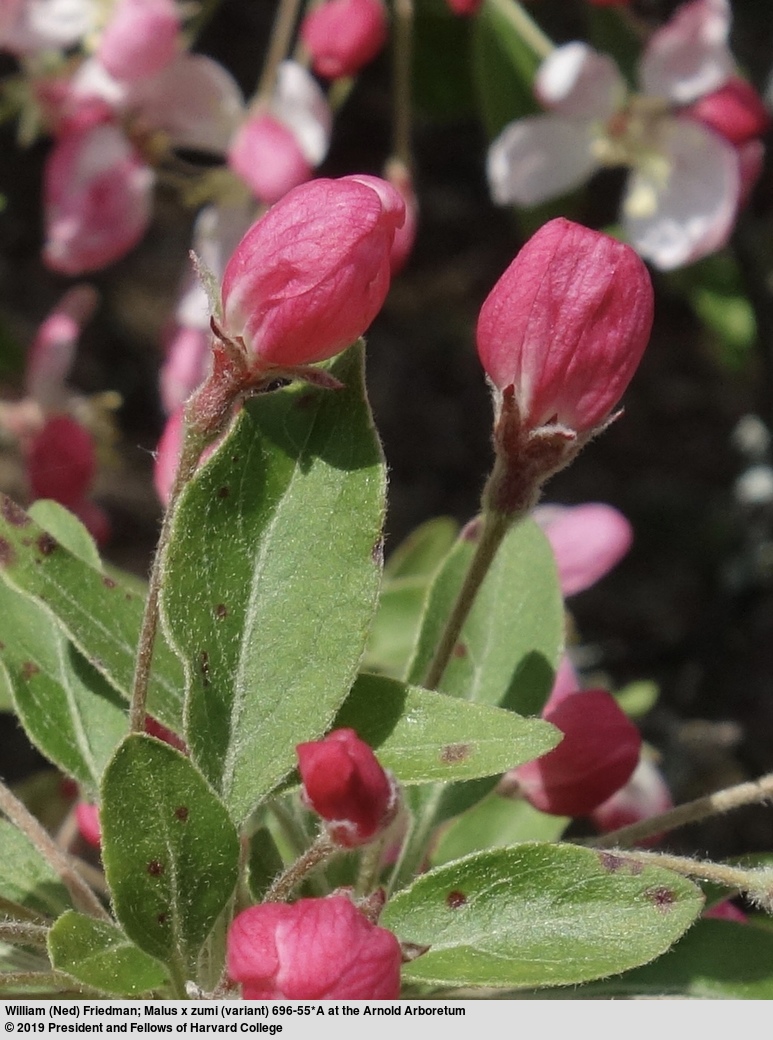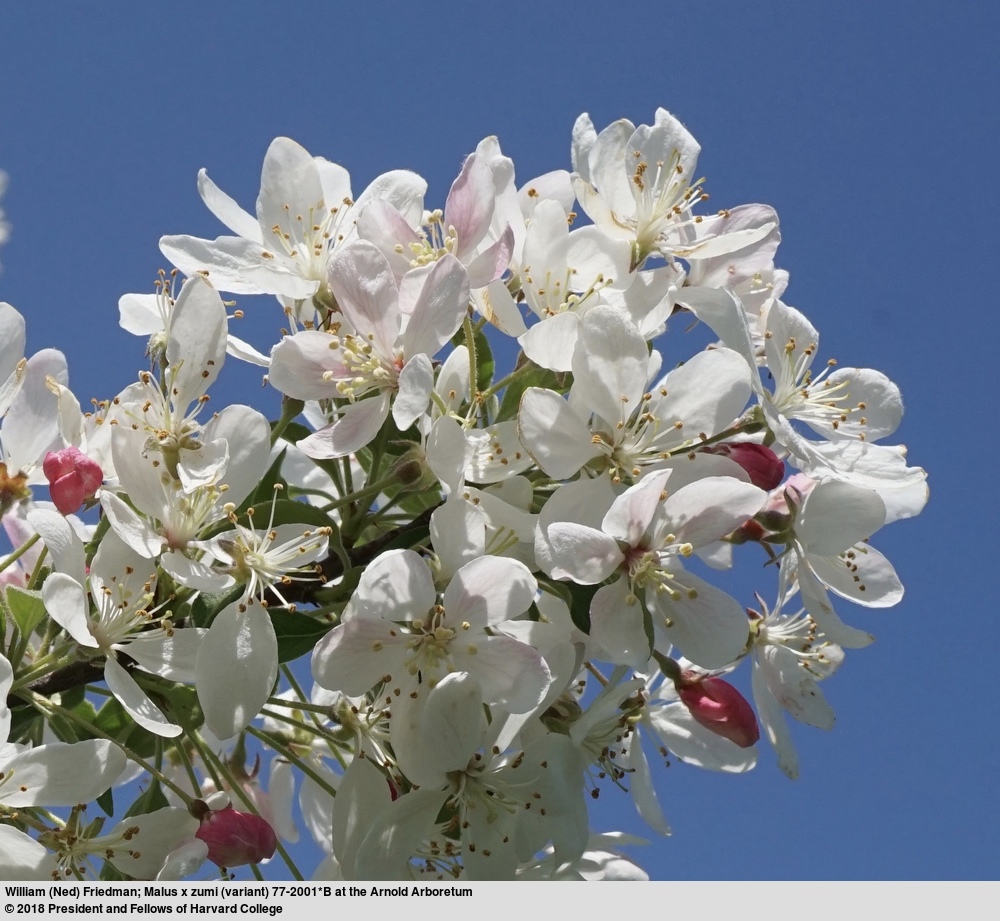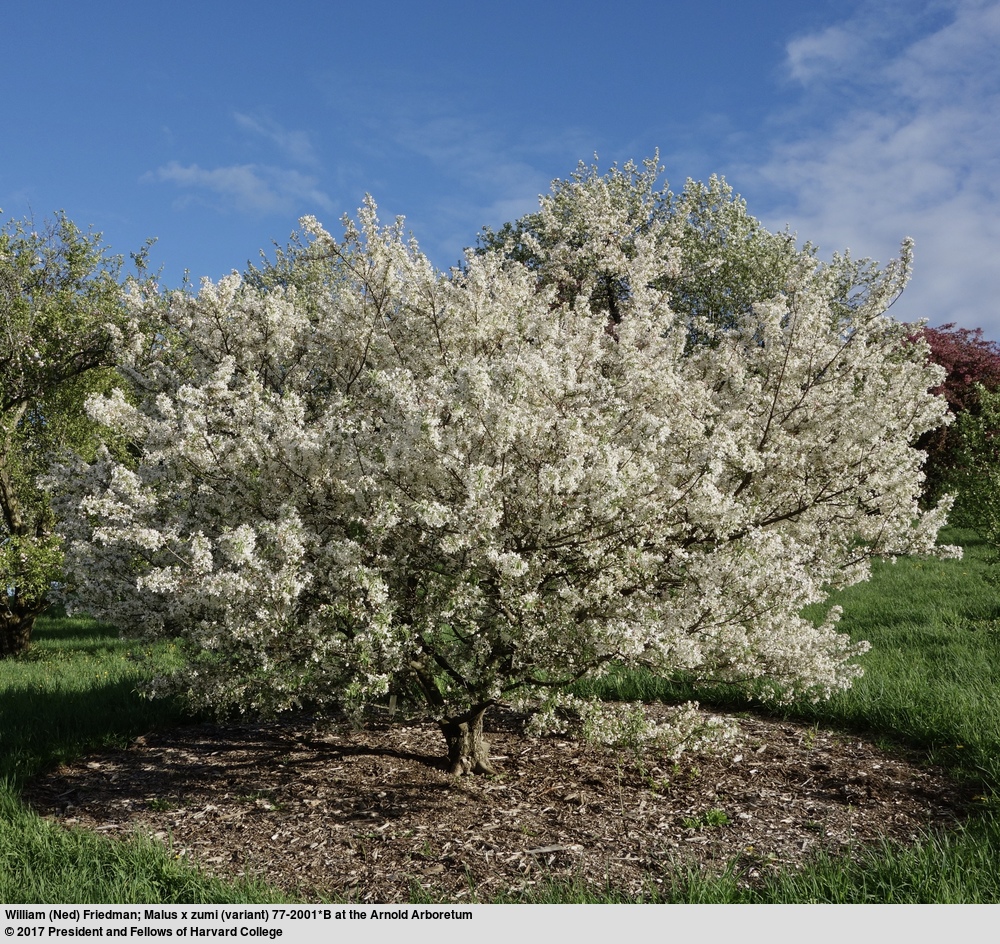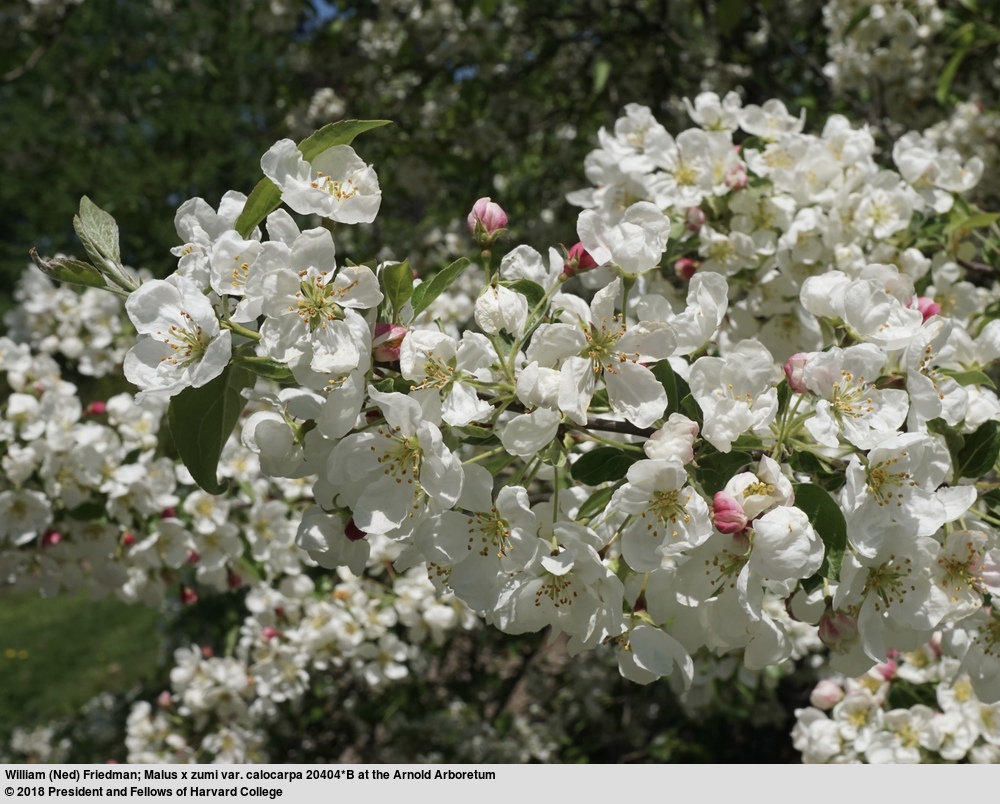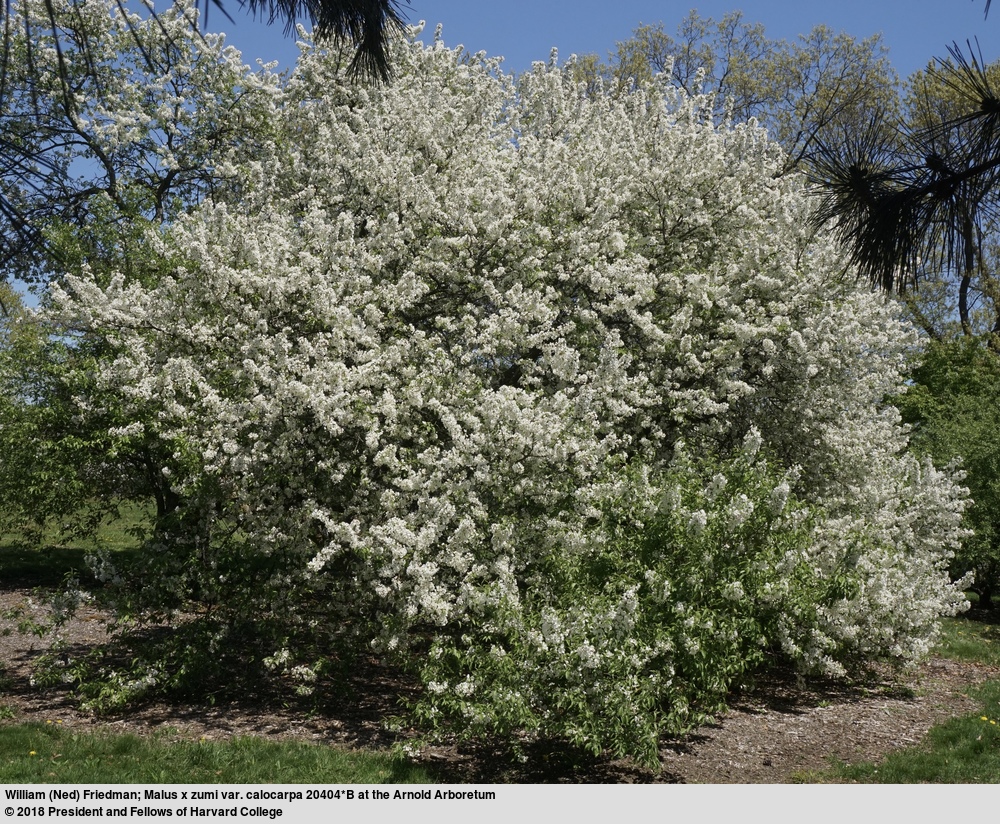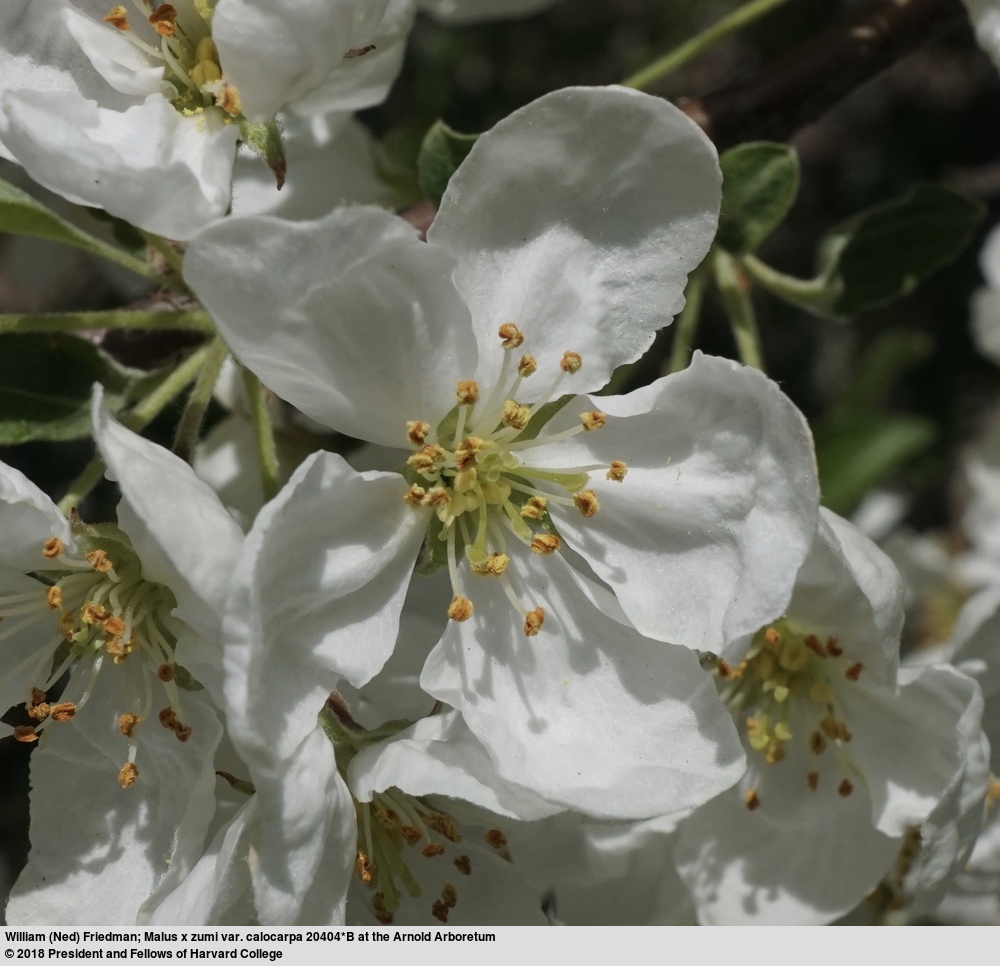Malus × zumi
Sponsor
Kindly sponsored by
Francine: 'after many informative Tours and Study Days with the IDS I feel it only fitting to help and promote such a wonderful organisation'
Credits
Julian Sutton (species), Nick Dunn (cultivars) (2021)
Recommended citation
Sutton, J. & Dunn, N. (2021), 'Malus × zumi' from the website Trees and Shrubs Online (treesandshrubsonline.
Genus
Synonyms
- Malus toringo var. zumi (Matsum.) H. Hara
- Malus sieboldii var. zumi (Matsum.) Asami
- Malus sieboldii (Rehd.) Fiala
- Pyrus zumi Matsum.
Infraspecifics
Other taxa in genus
- Malus × adstringens
- Malus angustifolia
- Malus × arnoldiana
- Malus asiatica
- Malus × astracanica
- Malus × atrosanguinea
- Malus baccata
- Malus bhutanica
- Malus × brevipes
- Malus chitralensis
- Malus coronaria
- Malus crescimannoi
- Malus Cultivars A-B
- Malus Cultivars C
- Malus Cultivars D-F
- Malus Cultivars G-I
- Malus Cultivars J-K
- Malus Cultivars L-M
- Malus Cultivars N-Q
- Malus Cultivars R
- Malus Cultivars S
- Malus Cultivars T-Z
- Malus dasyphylla
- Malus × dawsoniana
- Malus domestica
- Malus doumeri
- Malus florentina
- Malus × floribunda
- Malus fusca
- Malus × gloriosa
- Malus halliana
- Malus × hartwigii
- Malus × heterophylla
- Malus honanensis
- Malus hupehensis
- Malus ioensis
- Malus kansuensis
- Malus kirghisorum
- Malus komarovii
- Malus × magdeburgensis
- Malus × micromalus
- Malus × moerlandsii
- Malus montana
- Malus ombrophila
- Malus orientalis
- Malus × platycarpa
- Malus praecox
- Malus prattii
- Malus prunifolia
- Malus × purpurea
- Malus × robusta
- Malus rockii
- Malus Rootstock Cultivars
- Malus Rosybloom Cultivars
- Malus × scheideckeri
- Malus sieversii
- Malus sikkimensis
- Malus × soulardii
- Malus spectabilis
- Malus spontanea
- Malus × sublobata
- Malus sylvestris
- Malus toringo
- Malus transitoria
- Malus trilobata
- Malus tschonoskii
- Malus turkmenorum
- Malus yunnanensis
Uncertain taxonomic status (see below) and a tendency for rather variable descriptions to be based on single specimens make a definitive description impossible. Recognizing this, Jacobson (1996) made a ‘realistic conservative’ description of M. × zumi as known in gardens, which we quote verbatim. ‘Tree to 39’ [12 m] but usually half that or less. Scantily hairy floral parts. Pink buds open to white flowers which totally blanket the tree, 1”-1⅓” (1¾”) [2.5–3.4(–4.4) cm] wide. Leaves tawny, especially beneath; persistently hairy on both sides, or tardily becoming nearly hairless; nearly always unlobed but can be weakly lobed on strong shoots; leaves on fertile branchlets nearly or partially untoothed. Fruit profuse, yellow-green becoming red-cheeked, yellow-red or wholly red, 7/16”-11/16” [1.1–1.7 cm] long; the calyx drops.’
Distribution Japan Honshu
USDA Hardiness Zone 4-8
RHS Hardiness Rating H6
While it is a well-known name in gardens, the entire concept of Malus × zumi is troublesome. The plants it refers to are clearly wild in Honshu, if rare (Wilson in Sargent 1916; Ohwi 1965), and have similarities to both M. toringo and M. baccata var. mandshurica. Japanese floras (Iketani & Ohashi 2001; Ohwi 1965) have treated it as a variety of a variable M. toringo, with leaves usually or always unlobed, usually 4 or 5 styles (rather than 3 or 4) and perhaps larger leaves, 7–11 cm long. In western horticultural botany, the Rehder-Sargent-Wilson group at the Arnold Arboretum in the early 20th century clearly found it problematic (many references include Rehder in Sargent 1905 and Wilson in Sargent 1916); they treated it variously as a full species and as a hybrid between M. toringo and M. baccata var. mandshurica. Fiala (1994) firmly stated ‘Its relationship as a hybrid should be severed once and for all!’ but gave no clear reason; most unhelpfully, he named it M. sieboldii (Rehd.) Fiala, but distinct from M. toringo, a treatment widely – and sensibly – ignored. We style it as a nothospecies M. × zumi following Royal Botanic Gardens, Kew (2020) and most contemporary horticultural usage, without making any judgement on its status.
Early introductions to cultivation include seed brought to the Arnold Arboretum in 1892 by Charles Sprague Sargent, from near Fukushima (Rehder in Sargent 1905). ‘Calocarpa’ was raised at the Arnold from seed sent from Japan in 1890 by the American enthusiast for all things Japanese, William Bigelow (Fiala 1994). There have been numerous subsequent introductions, though none of outstanding significance.
Trees identified simply as M. × zumi are infrequent in Europe. There are two examples at RBG Edinburgh, one from 1917 measured at 9 m × 142 cm in 2014 (Royal Botanic Garden Edinburgh 2020; The Tree Register 2020), and two tall specimens of 12 m and 14 m (2014) at Westonbirt (The Tree Register 2020). In Belgium it is recorded at Meise Botanic Garden and the Arboretum Robert Lenoir (Plantcol 2020).
In North America, Jacobson (1996) considers it common since before 1930, although it is no longer much in the nursery trade except as cultivars. It is widespread in specialist collections in the northern United States (Arnold Arboretum 2020; Chicago Botanic Garden 2020; Morton Arboretum 2020; University of Washington Botanic Gardens 2020).
As well as the wild-origin ‘Calocarpa’, ‘Professor Sprenger’ seems to belong here, but open pollinated seedlings which are probably more complex hybrids are sometimes also listed under M. × zumi; ‘Golden Hornet’ (see ‘Cultivars G-I’) is a frequent example.
'Calocarpa'
Selected at the Arnold Arboretum from seed sent from Japan by William Bigelow in 1890. Nurseries have sometimes offered variable seedlings under the name. The notes below are based on Fiala’s (1994) description of the original Arnold clone. An important parent of hybrid cultivars.
Growth Rate/Size: Medium (<6 m)
Form/shape/habit: Dense, upright to spreading
Foliage: Green, only the later-emerging leaves lobed
Flower colour: Blush to white, from deep red buds
Flower size: Medium (<4 cm)
Flower form: Single
Fruit size: Small (<2 cm)
Fruit colour: Bright red to orange-red
Fruit season: Persistent
Disease resistance/susceptibility: Resistant
(Description duplicated under Malus Cultivars C ‘Calocarpa’)
'Professor Sprenger'
A clone worthwhile for its fragrant flowers and bright showy fruit.
Growth Rate/Size: Medium (<6 m)
Form/shape/habit: Upright, spreading
Foliage: Green
Flower colour: White from rose-pink buds
Flower size: Medium (<4 cm)
Flower form: Single
Flower season: Mid
Fruit size: Small (<2 cm)
Fruit shape: Round
Fruit colour: Golden-yellow blushing pink.
Fruit season: Late
Disease resistance/susceptibility: Resistant
Raiser/collector: Simon Doorenboos, The Hague, Netherlands.
Date of introduction: Before 1950
General notes: Similar in flower to M. ‘Evereste’ but the fruit is smaller and persists well into December. A popular pollinator in commercial apple orchards. The name honours A.M. Sprenger, University of Wageningen.
(Description duplicated under Malus Cultivars N-Q ‘Professor Sprenger’)


